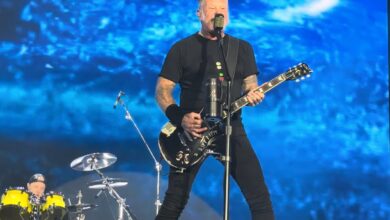Metallica Set Brisbane Ablaze with a Frenetically Explosive “Moth Into Flame” at Suncorp Stadium 2025
By the time Brisbane finally got to “Moth Into Flame,” Suncorp Stadium felt less like a sports venue and more like the inside of a jet engine. The night had already been heavy: Creeping Death, For Whom the Bell Tolls, Fuel, Ride the Lightning, The Unforgiven, Wherever I May Roam, the Chats “Smoko” doodle, and a sprawling The Day That Never Comes had all rolled past in a blur of riffs and fireworks. You could sense the band shifting gears from classic-era nostalgia into something sharper and more current, and that’s exactly where “Moth Into Flame” came roaring in.
What made this particular performance special started long before the first note. For Australian fans, “Moth Into Flame” has a weird emotional weight because the original Hardwired…To Self-Destruct tour never properly landed here; cancellations meant a whole continent missed the first real live cycle of that era. In the days before the Brisbane show, fans on forums and Reddit were literally saying, “If we at least get Moth Into Flame this time, I’ll be happy.” So when the opening chug finally hit at Suncorp, it didn’t just sound like another song in the setlist—it felt like a long-overdue debt being paid back with interest.
The segue into it was cinematic. The Day That Never Comes ended in its usual blaze of machine-gun riffing and blinding strobes, and for a few seconds the stadium hung in that suspended, sweaty silence where nobody is sure what’s coming next. Then Lars snapped into that tight, urgent drum pattern, Hetfield dug into the jagged main riff, and the screens exploded into a flurry of white-hot, glitchy visuals that looked like digital moths attacking a light source. Those first few bars set off a second wind in the crowd—people who had been catching their breath suddenly found themselves shoving back to their feet, phones in the air, ready to document the moment they’d been quietly hoping for.
Hetfield sounded ferocious on the verses, leaning into the syllables like he was chewing through them. “Blacked out, pop queen, amphetamine…” came out less as commentary and more as accusation, his vocal tone somewhere between snarl and warning siren. It was a reminder that even though the song is relatively new in Metallica terms, it taps straight into the same cynical streak that powered their 80s material, only now aimed at influencer culture and the glare of viral fame. Hearing that lyric about “infamy, all for publicity” bounce around a stadium full of people filming every second on their phones gave the entire performance a deliciously self-aware edge.
Kirk Hammett seemed to relish this one. Where some of the older songs have him stepping into well-worn solo shapes, “Moth Into Flame” lets him dance along a more modern, almost spiraling lead line that matches the song’s frantic pace. In Brisbane, he took that solo and stretched it just far enough to feel dangerous without losing the thread—little extra bends here, a slightly longer sustain there, playing off the crowd’s energy as the cameras caught tight shots of his fingers racing over the fretboard. The circular M72 stage meant he could prowl all the way around, throwing licks toward every quadrant of Suncorp as the lights chased him like, appropriately, a moth chasing a flame.
Down in the Snake Pit—the tiny standing area carved out inside the ring of the stage—things were even more intense. It’s no coincidence that one of Metallica’s enhanced experience packages for this tour is literally called the “Moth Into Flame Snake Pit Experience”; for those fans, this song is basically their personal national anthem. When the track kicked in, the pit became a centrifuge of denim, black t-shirts, flying hair, and raised horns, with people spinning and bouncing as if they were trying to match the song’s RPM in real time. From the stands, you could see pockets of motion surging and collapsing around the inner barrier like waves slamming into a hull.
Robert Trujillo and Lars Ulrich, as usual, were the engine room holding the whole thing together. Trujillo’s bass tone on this tour has been dialed into something close to perfect: thick enough to rattle the seats but defined enough that you can hear every locked-in gallop with the kick drums. Moth Into Flame lives or dies on that tight rhythmic grid, and in Brisbane the pulse never once wobbled. Lars, playing from his B-kit as he did for much of the latter half of the set, drove the song with a mix of precision and swagger, pushing the choruses just a hair faster so that by the final refrain, the whole performance felt like it was teetering on the edge of losing control—in the best way.
Visually, the song might have been one of the night’s most striking moments. The screens leaned into harsh whites, sickly yellows, and fast-cut imagery: flickering bulbs, abstract flames, vague silhouettes that looked like crowds clawing at barriers. Combined with the relentless strobe and the cold white beams sweeping the stadium, it created the sense that everyone inside Suncorp was onstage with the band, all trapped in the same blaze. The LEDs wrapped around the entire in-the-round setup gave the impression of being inside a huge, burning cylinder—a pretty on-the-nose but wildly effective translation of the song’s concept into stagecraft.
What really set this performance apart, though, was how loudly the crowd owned it. “Moth Into Flame” doesn’t have the decades of repetition behind it that something like Enter Sandman or Master of Puppets does, but you wouldn’t have known that from Brisbane’s reaction. When the pre-chorus hit—“Guarantee your name, you go and kill yourself”—you could hear entire stands spitting the line back at Hetfield, word-perfect, like they’d been rehearsing for a year. By the second chorus, that call-and-response had turned into a thunderous, unified roar, the kind of thing that makes the hair on your arms stand up even if you’re only watching it back through someone else’s wobbly phone video.
There was also a particular electricity in knowing this was happening in the middle of a run that had already become a talking point across Australia. Perth, Adelaide, and Melbourne had each gotten their own version of the M72 experience, complete with city-specific Kirk and Rob doodles and slight variations in the setlist. Brisbane fans had watched all of that play out online in real time, speculating on what they’d get, trading predictions, and building their dream lists. When the real show finally arrived and included both an old-school curveball like Ride the Lightning and a modern burner like Moth Into Flame, it felt like the city had scored the perfect balance.
In a way, “Moth Into Flame” became the bridge between the different emotional worlds of the night. On one side, you had the towering, mythic classics—Creeping Death, For Whom the Bell Tolls, Seek & Destroy, Master of Puppets—that tap directly into the band’s 80s fury. On the other, you had the introspective sweep of The Day That Never Comes and the communal catharsis of Nothing Else Matters. Sitting in the middle, this song managed to feel both vicious and weirdly reflective, like Metallica holding a mirror up to the fame machine they’ve been caught in for four decades and inviting an entire stadium to scream along about how insane it all is.
For fans who shelled out for travel, hotels, and merch, that single performance alone probably justified the expense. Some of the earliest post-show social posts from Brisbane circled the title on setlist photos, underlined it, and simply wrote “Finally.” Others uploaded shaky clips of the final chorus with captions like “This is why you see Metallica live” or “Worth the 12-year wait.” When you combine that with the official Moth Into Flame-branded experiences, it’s clear the band understands just how much this track means to a certain slice of their audience, especially in places that got skipped the first time around.
Stepping back from the specifics, the Brisbane rendition of “Moth Into Flame” did something that only the best live performances manage: it made a relatively recent song feel like a cornerstone of the catalogue. By the time the last crash cymbal rang out and the band shifted gears into the swampy stomp of Sad But True, there was this shared sense in the air that everyone had just witnessed something that would stand up alongside the legendary bootlegs and pro-shot clips fans have been trading for decades. You could almost hear future arguments being born—people insisting, years from now, that the definitive version of the song came from this very night in Queensland.
And that might be the real magic of it. With so much of modern concert-going filtered through screens, algorithms, and post-show content, the Brisbane performance of “Moth Into Flame” somehow managed to feel defiantly, gloriously live. It wasn’t perfect in a sterile, studio sense; it was sweaty, breathless, and a little unhinged around the edges, exactly like a song about burning yourself up for attention should be. In the middle of a carefully engineered stadium spectacle, it was the moment where the whole thing briefly felt spontaneous and slightly dangerous—a reminder that Metallica, even this deep into their career, can still set off alarms rather than just ring nostalgia bells.
By the time the set thundered on toward Lux Æterna, Master of Puppets, One and the inevitable Sandman closer, people were still turning to each other between songs and saying some variation of, “I can’t believe we finally got Moth.” That’s the mark of a performance that cuts through all the noise: it becomes a reference point for everyone who was there. Years from now, when fans talk about Metallica finally roaring back into Brisbane in 2025, they’ll mention the AC/DC intro, the Chats cover, the fireworks, and the sold-out chaos. But somewhere near the top of that list, they’ll remember the exact moment the lights went harsh, the riff kicked in, and 50,000 people collectively hurled themselves straight into the flame.





